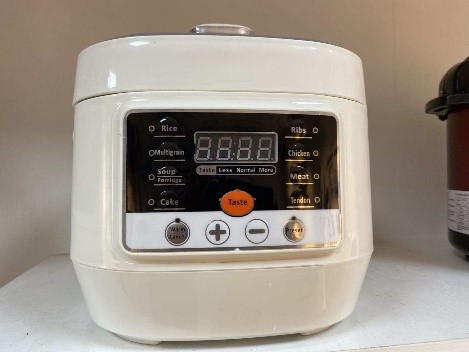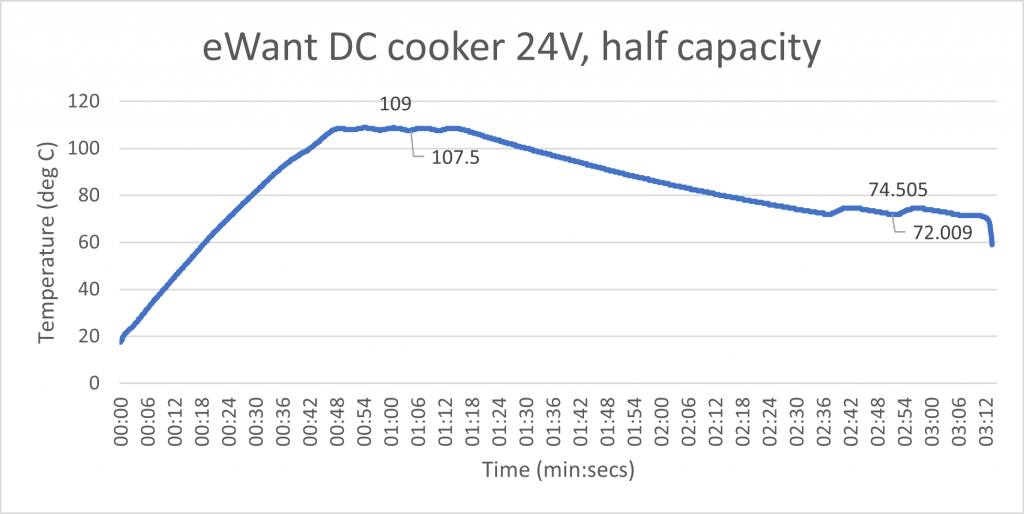
- Date
- 7th April 2021
- Categories
By Dr Simon Batchelor (Gamos Ltd.)

Other work has established that electric pressure cookers have good possibilities for households to save money on their fuels and to move towards a clean cooking, modern energy cooking experience. Building on that breadth of work we note that while most commercially available electric pressure cookers work on 110V or 230V Alternating Current (AC), there has been some discussion in the off-grid solar home system community and the off-grid solar DC mini-grid community of a need for a Direct Current EPC.
In theory, maintaining the direct current form of electricity from the battery, without inversion, and using it to power a DC EPC, could be more efficient than converting to AC electricity. In most cases at the moment, energy storage on domestic systems tends to be a chemical battery, and in recent years this has shifted from being lead acid based to lithium iron phosphate. A lower power device has a potential to ensure that batteries are not subject to rapid discharge that exceeds their C rate. A low power device will be useful for the transition and upgrading from home lighting systems to systems that can include the cooking load. A direct current appliance does remove the need for an inverter, and as such reduces the system cost, contributes to the overall system design and system efficiency.
We have had disappointments – in a fairly extensive search online and in discussion with Chinese factories, during 2017 to 2019, the only direct current electric pressure cooker on the market was the BES 12V and 24V versions. These devices were tested by Loughborough University, Centre for Renewable Energy Science and Technology (CREST). In a ‘A Comparison of Functions and Safety Features on Electric Pressure Cookers’ the CREST team at Loughborough documented the functions and safety features of a range of commercial electric pressure cookers. The paper stated concerns over the safety of the 12V EPC. These concerns were echoed in “A brief performance and safety assessment of a 24V DC Electric Pressure Cooker intended for the Chinese domestic market”, and recently the BES Tesga appliance were removed from the Global Leap Awards due to safety concerns.
This has been a deep frustration – a 24V DC EPC has been on our wish list as a programme for the last 2 years. With a lack of alternatives on the market the MECS programme has been actively seeking to stimulate production of a DC cooker. This has included visits to key factories in China, and discussion with designers and manufacturers. In 2020, a new Direct Current EPC was identified, made by the Foshan Shunde Ewant Electrical Technology Co Ltd who market their products under the name eWant.
A sample of six devices were brought to the UK for tests. The resulting working paper takes the appliance through most of the tests found in the Global Leap test protocol for electric pressure cookers.

The eWant 24V DC electric pressure cooker presents as a well-made appliance that would safely deliver a cooking experience. It pressurises, switches itself on and off, locks the lid under pressure and has most of the features of modern electric pressure cookers used in Europe and the USA on mains AC electricity. At such a low power rating, the EPC takes longer than most commercial AC EPCs to reach the pressure phase, and those experienced in the use of EPCs might find that ‘slow’. However, this unit will likely be used by rural households who are used to gathering firewood, preparing a fire, waiting for the fire to get to heat and then cooking – and when considering the total time required for cooking, the appliance will likely give a much appreciated reduction in overall time. It will also give a clean, convenient (the unit can be left while cooking) and aspirational experience. Some types of frying may not be possible – further research is required.
As a DC appliance it is a very welcome addition to the toolkit of off-grid appliances that can work on solar home systems where there is no grid connection. It can be considered an energy efficient appliance, that utilises pressure cooking to reduce cooking times for ’long cook’ foods such as beans. As a DC appliance it alleviates the need for an inverter between battery and appliance, and may reduce system cost.
Since many rural families are relatively large, there is a hesitation that the users may find that it is too small at 2 litres pot (officially 2.5 litres). However, if it used as an introduction to an aspirational product that alleviates smoke and has the convenience of modern energy cooking then it may find a market.
It is worth noting that the early lights of Solar Home Systems were not powerful and could barely give enough light to see, let alone read and do homework. As the solar lights have been introduced learning gains have been made and products on the market now are sophisticated and with significant energy efficiency. This EPC offers a similar starting point where it may not fulfill the optimum needs of the household but brings a level of modernity that leads on to learning gains.
It is not yet advertised on the company website, but enquiries through Alibaba can yield delivery of what is now a commercial product. The company is working toward a larger appliance with a larger pot operating at 36V DC at 500W.
…………………………………………………………………………………………………………………………
Featured image: Photo by Sharon Pittaway on Unsplash.